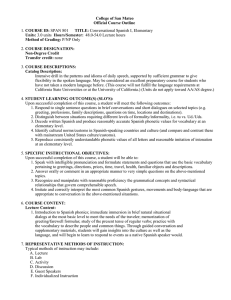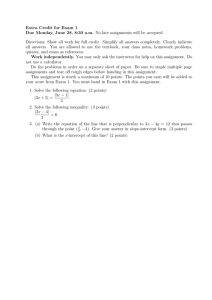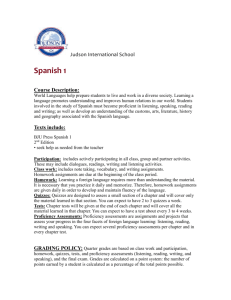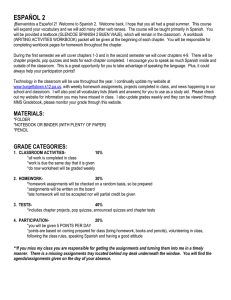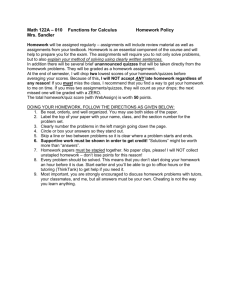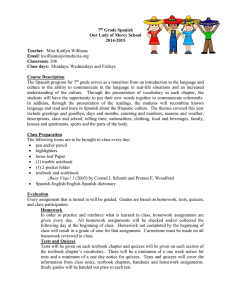College of San Mateo Official Course Outline COURSE ID: Units:
advertisement
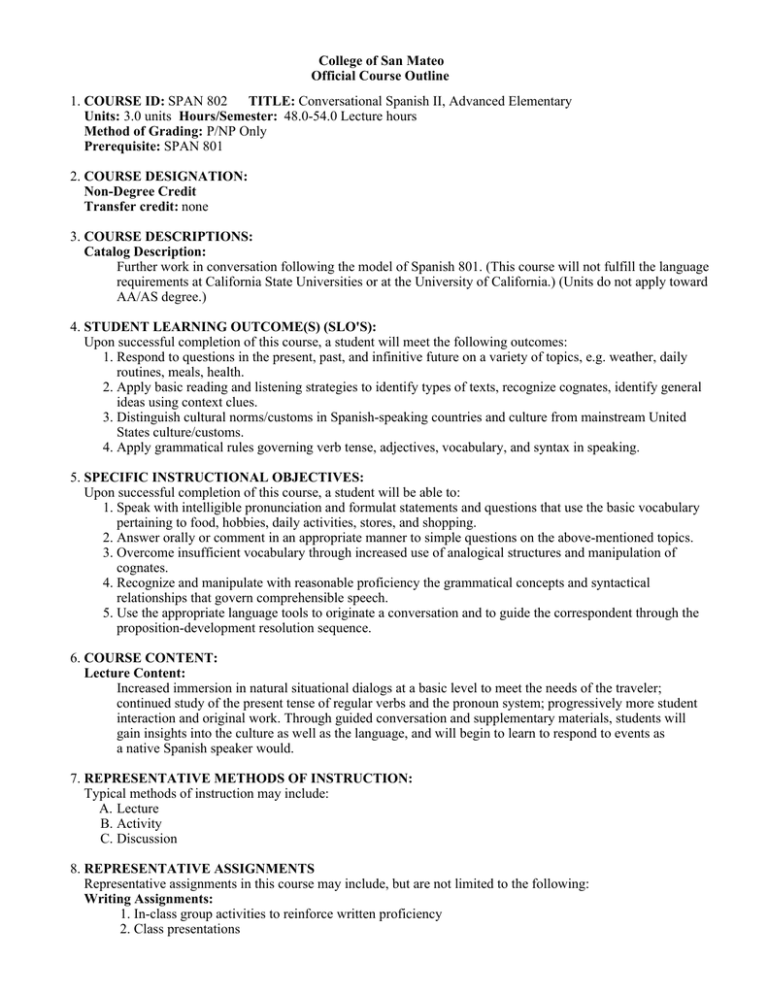
College of San Mateo Official Course Outline 1. COURSE ID: SPAN 802 TITLE: Conversational Spanish II, Advanced Elementary Units: 3.0 units Hours/Semester: 48.0-54.0 Lecture hours Method of Grading: P/NP Only Prerequisite: SPAN 801 2. COURSE DESIGNATION: Non-Degree Credit Transfer credit: none 3. COURSE DESCRIPTIONS: Catalog Description: Further work in conversation following the model of Spanish 801. (This course will not fulfill the language requirements at California State Universities or at the University of California.) (Units do not apply toward AA/AS degree.) 4. STUDENT LEARNING OUTCOME(S) (SLO'S): Upon successful completion of this course, a student will meet the following outcomes: 1. Respond to questions in the present, past, and infinitive future on a variety of topics, e.g. weather, daily routines, meals, health. 2. Apply basic reading and listening strategies to identify types of texts, recognize cognates, identify general ideas using context clues. 3. Distinguish cultural norms/customs in Spanish-speaking countries and culture from mainstream United States culture/customs. 4. Apply grammatical rules governing verb tense, adjectives, vocabulary, and syntax in speaking. 5. SPECIFIC INSTRUCTIONAL OBJECTIVES: Upon successful completion of this course, a student will be able to: 1. Speak with intelligible pronunciation and formulat statements and questions that use the basic vocabulary pertaining to food, hobbies, daily activities, stores, and shopping. 2. Answer orally or comment in an appropriate manner to simple questions on the above-mentioned topics. 3. Overcome insufficient vocabulary through increased use of analogical structures and manipulation of cognates. 4. Recognize and manipulate with reasonable proficiency the grammatical concepts and syntactical relationships that govern comprehensible speech. 5. Use the appropriate language tools to originate a conversation and to guide the correspondent through the proposition-development resolution sequence. 6. COURSE CONTENT: Lecture Content: Increased immersion in natural situational dialogs at a basic level to meet the needs of the traveler; continued study of the present tense of regular verbs and the pronoun system; progressively more student interaction and original work. Through guided conversation and supplementary materials, students will gain insights into the culture as well as the language, and will begin to learn to respond to events as a native Spanish speaker would. 7. REPRESENTATIVE METHODS OF INSTRUCTION: Typical methods of instruction may include: A. Lecture B. Activity C. Discussion 8. REPRESENTATIVE ASSIGNMENTS Representative assignments in this course may include, but are not limited to the following: Writing Assignments: 1. In-class group activities to reinforce written proficiency 2. Class presentations 3. Written homework, e.g. production of short dialogues and paragraphs 3. Written homework, e.g. production of short dialogues and paragraphs 4. Quizzes and tests Reading Assignments: 1. In-class group activities to reinforce reading proficiency 2. Reading exercises and homework 3. Model dialogues and short passages 4. Quizzes and tests 9. REPRESENTATIVE METHODS OF EVALUATION Representative methods of evaluation may include: A. Class Participation B. Class Work C. Exams/Tests D. Homework E. Oral Presentation F. Quizzes G. 1) Active participation in class, 2) demonstration of the ability to respond appropriately to the questions or comments of another speaker, 3) periodic oral quizzes or examinations, 4) increased fluency and spontaneity in Spanish, 5) a final examination - comprehensive or topical- or a final class activity deemed appropriate to the materials covered during the semester. 10. REPRESENTATIVE TEXT(S): Other: A. Hola, Amigos!. Ana Jarvis, Raquel Lebredo and Francisco Mena-Ayllon (2013). Origination Date: August 2014 Curriculum Committee Approval Date: September 2014 Effective Term: Fall 2015 Course Originator: James Carranza
